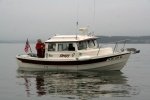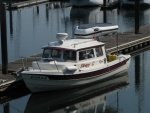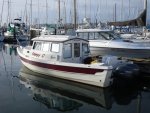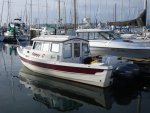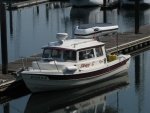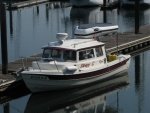As some of you know, I am a firm proponent of twin engines. One of the reasons is because I thoroughly enjoy the pleasures of low speed, intricate directional control, in confined spaces.
On my summer trip on Vancouver Island, I had some steering fluid leak and as a result have been researching some SeaStar info here on the CBRATs site. One of the threads I ran across had some comments about steering, loss of, and the possible results.
The thread is here:
http://www.c-brats.com/viewtopic.php?t= ... ks&start=0
And one of the comments, speaking of hydraulic steering system on twin OB’s “So if it does fail entirely, I would be screwed.”
On that trip, I had the opportunity to watch dozens of twin engine out board vessels, in lots of different situations, and rarely saw where the operator used the twin engines in other than a single engine steering mode, turning the wheel as both engines rotate accordingly. On one occasion, I watched a skipper struggle for several minutes, taking 5 or 6 trys to get into a berth. On each attempt there was at least one exchange of gel coat and more than a little blue air. In another instance, there was a telltale long dark streak on the side of a big white sail boat.
Early on in my experience with my twin engine C-Dory, I had a chance to hear from a couple who just returned to Everett, I believe it was, from Friday Harbor, with a twin engine C-Dory 22 who had suffered a loss of their steering system. It was not a big concern for them, and he introduced me to the concept of differential throttle control. It was shortly after that, I was told to take my hands off the wheel when I was having difficulty getting into a slip at John Wayne Marina. That gentleman came over and explained how it works in detail. It was “life changing”, and has become a standard practice once I’m inside the breakwater at the marina – any marina.
It is a simple process, based on simple physics. If one side goes forward and the other side goes in reverse, the boat will pivot. AND that pivot will be around a point very close to the point half way between the engines, and probably slightly forward of that. The point will vary depending on the relative RPM of each engine. If they are both in forward but at different speeds, the boat will turn in the direction of the slower engine.
It is worth trying, practicing and perfecting. Be sure your OBs are lined up midline or centered. That will make life much easier.
Have you tried it? Do you use it?
Harvey
SleepyC:moon
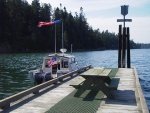
On my summer trip on Vancouver Island, I had some steering fluid leak and as a result have been researching some SeaStar info here on the CBRATs site. One of the threads I ran across had some comments about steering, loss of, and the possible results.
The thread is here:
http://www.c-brats.com/viewtopic.php?t= ... ks&start=0
And one of the comments, speaking of hydraulic steering system on twin OB’s “So if it does fail entirely, I would be screwed.”
On that trip, I had the opportunity to watch dozens of twin engine out board vessels, in lots of different situations, and rarely saw where the operator used the twin engines in other than a single engine steering mode, turning the wheel as both engines rotate accordingly. On one occasion, I watched a skipper struggle for several minutes, taking 5 or 6 trys to get into a berth. On each attempt there was at least one exchange of gel coat and more than a little blue air. In another instance, there was a telltale long dark streak on the side of a big white sail boat.
Early on in my experience with my twin engine C-Dory, I had a chance to hear from a couple who just returned to Everett, I believe it was, from Friday Harbor, with a twin engine C-Dory 22 who had suffered a loss of their steering system. It was not a big concern for them, and he introduced me to the concept of differential throttle control. It was shortly after that, I was told to take my hands off the wheel when I was having difficulty getting into a slip at John Wayne Marina. That gentleman came over and explained how it works in detail. It was “life changing”, and has become a standard practice once I’m inside the breakwater at the marina – any marina.
It is a simple process, based on simple physics. If one side goes forward and the other side goes in reverse, the boat will pivot. AND that pivot will be around a point very close to the point half way between the engines, and probably slightly forward of that. The point will vary depending on the relative RPM of each engine. If they are both in forward but at different speeds, the boat will turn in the direction of the slower engine.
It is worth trying, practicing and perfecting. Be sure your OBs are lined up midline or centered. That will make life much easier.
Have you tried it? Do you use it?
Harvey
SleepyC:moon


